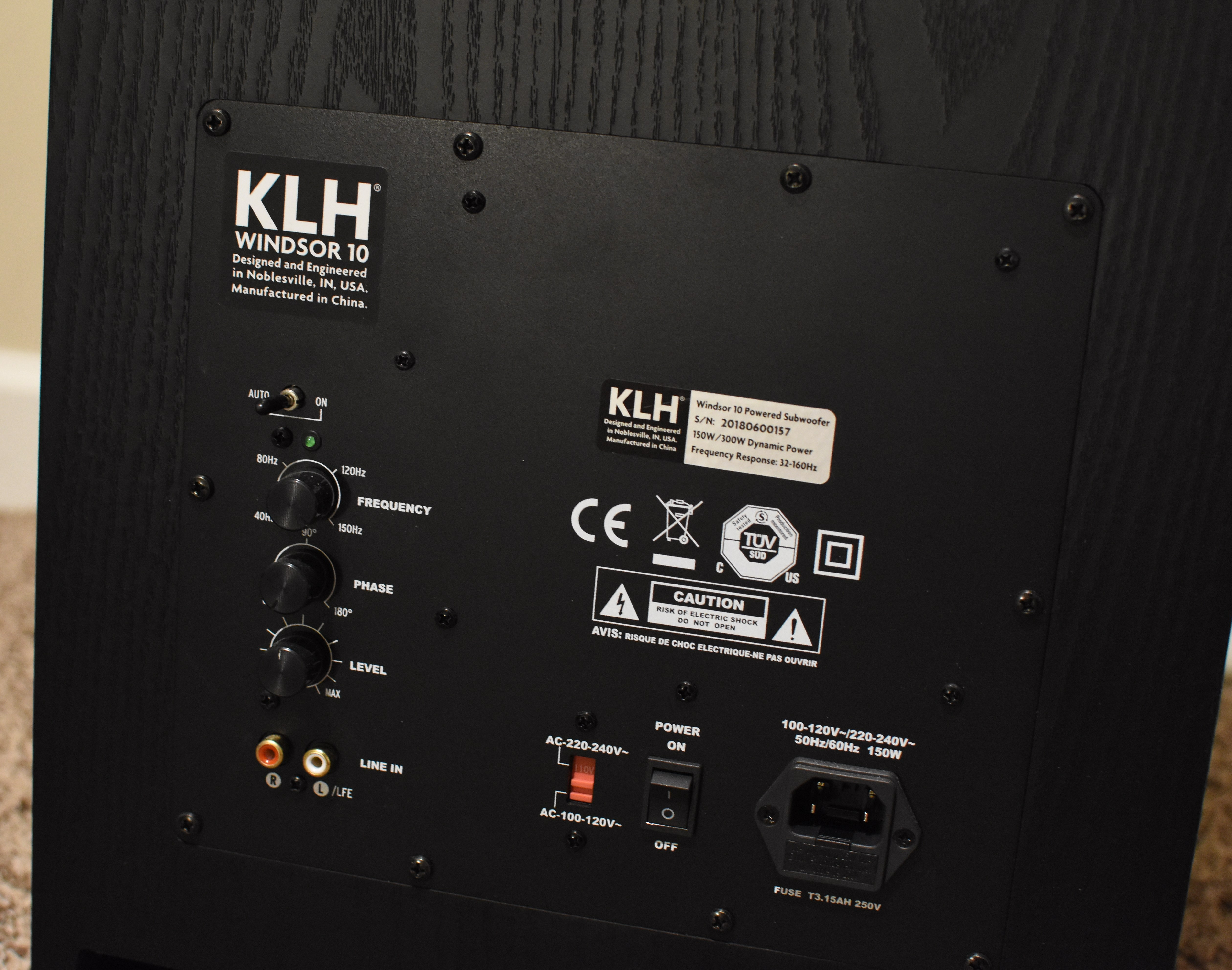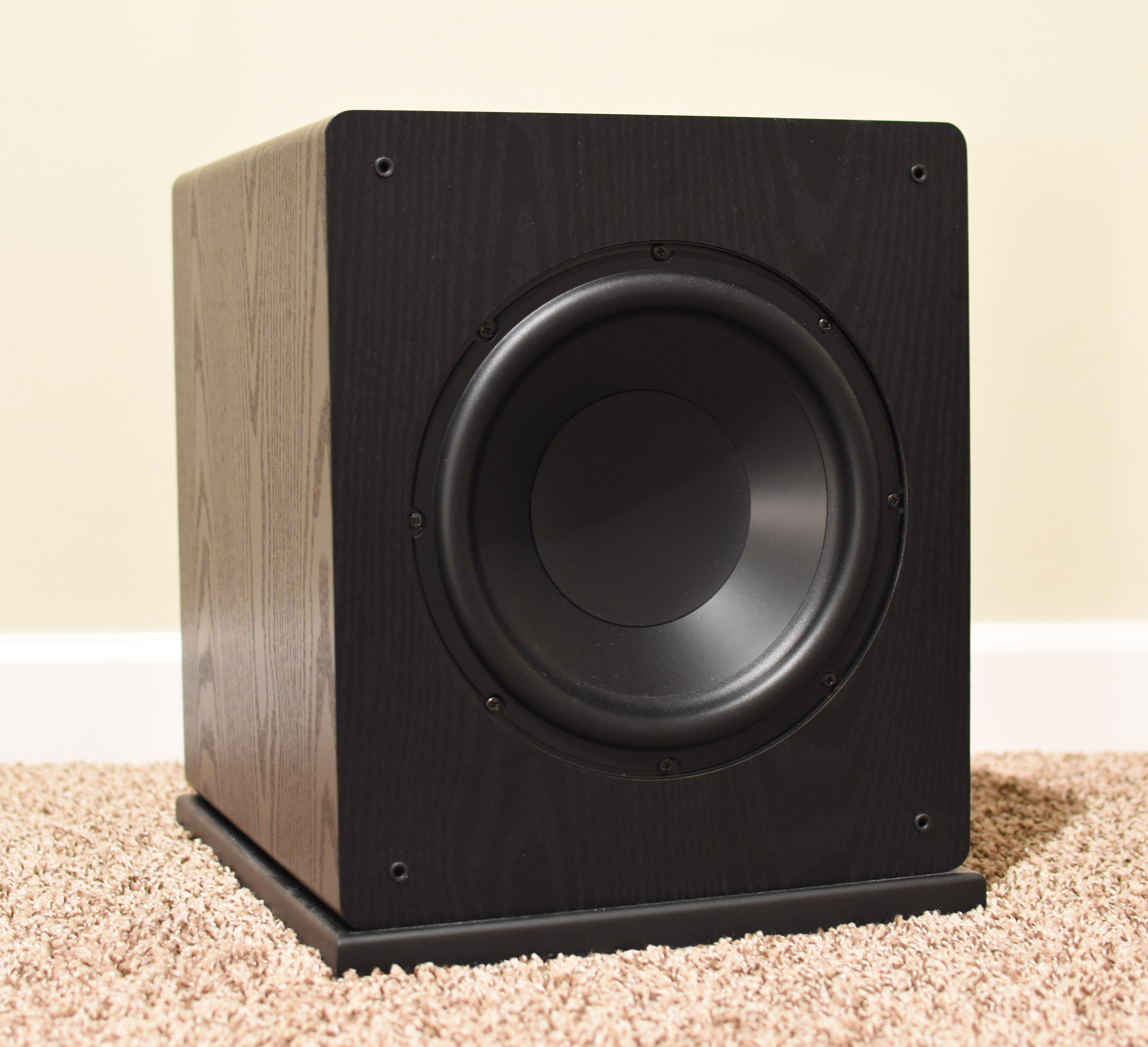Introductions
KLH is an audio company founded by three people, Henry Kloss, Malcolm S. Low, and Josef Anton Hofmann. It was founded as KLH research and was focused on producing loudspeakers. If you didn’t already realize, KLH are the initials of the last names of the founders, Kloss, Low and Hofmann. When it was founded in Cambridge, Massachusetts, in 1957, fun fact, they named the speakers after street names in Cambridge. I thought that was interesting, and having lived in Cambridge at one point in my life, it was doubly interesting for me.
Back to the product at hand, this is the Windsor 10, their $449 10 inch Subwoofer, which in this case was supposed to complement their 5.2 surround sound system for review by my dad. If you want to read up on that, I’ll hyperlink the article here. Long story short we have the system so now I have the opportunity to review this unit here. Although we received 2 to review, I’ll only be reviewing one of them as that is what I can do in my own system, which I’ve set-up naturally as a 2.1 along with my NHT SB1 in this case.

Specifications
Frequency response: 32Hz-160Hz
Maximum Output: 114dB.
Class “D” Digital Amplifier: 150W rms/300W Dynamic Power
Components: 10″ Driver, Proprietary Blend of Treated Paper, Kevlar®, CSX and Polyglass
Enclosure Material: MDF
Enclosure Type: Rear Slot Ported Bass Reflex
Inputs: L/R Line Level/LFE RCA Jacks
Finish: Black Oak Vinyl
Features: Volume, Lowpass, Phase, Auto Power
Phase: Switchable 0-180 degrees
Dimensions (H x W x D): 39.37cm x 32.5cm x 39.1cm
Notes on the specifications: When I looked at the specifications for the Windsor 10 on KLH’s website at the time of writing, somehow the first sentence specification didn’t add up. What it said is, “2-Way bass reflex system with 2 x 5.25” Woven Kevlar® bass/mid drivers, and a high performance 1” Anodized Aluminum tweeter with a linear response faceplate.” Those seemed more like non-sub specifications that were accidentally added in there by accident.
The rest seemed accurate however, so I only included that in the rest of the specification, not the first senetence.
Build Quality
Looking at the specifications, you will see that the Windsor is not actually a big subwoofer. It’s smaller than my Velodyne CT-100, and it barely fits the NAD T747 receiver I have on top of it. On that note, I’m pretty sure people don’t put a receiver on top of their subwoofer, but I am an outlier in that aspect and it’s just something I must mention for the sake of expressing size as well. The Velodyne CT-100 fits the receiver very comfortably and I need not worry about where exactly I have to put it on the Sub.

The finish of the Windsor 10 that I have here seems to have an artificially textured finish to make it feel like natural wood. Except it doesn’t feel like natural wood because of how smooth it is between the textures. After all it is vinyl as it says in the specs. A good thing about that, despite it being a small thing, is that you won’t get the obvious fingerprints like you do on a piano top type finish on speakers such as my NHT SB1.
Doing the knocking test on the Sub, I feel that the Windsor is actually slightly better braced than the Velodyne. The grill is attached via a tradition pin and cup method. The pin itself on the grill is of metal construction and feels very solid. The grill is also probably made of MDF and has quite the weight on it. It fits on the sub with a bit of a gap from the sub itself and the grill. The sub also seems to come included with a stand underneath. The rear of the Sub is where the main control is located and where the auto on/off, phase, and you inputs are located. Not to mention, the power is also through the back. Now notice that the power connector that is required is a 2 prong one. This means in terms of electrical, or whatever I know of electrical stuff, is that there is no physical ground to the power outlet from the sub itself. That presents a few complications in the listening experience I had, which I will explain below.

First of all, I must say that this had cleared up an issue for me fundamentally for my system. I realized that just having a generic red and white cable from the receiver to the sub might not cut it in this situation. I had to switch to a specifically sub out cable that could handle LFE signals better. But this also revealed a flaw in the sub electronics itself. For long listening sessions of about more than 4 hours, which I have done a lot doing college homework and whatnot, there appears to be sputtering in the sub. Literally you will hear the sub sputtering through the music you are listening to, and will persist even after you have stopped the music. The only solution to this is to let it resolve itself, based on what I’ve tried doing. This happened once in the review process for the 5.2 system where a sub literally died after sputtering, But I realized not too long after switching cables diagnosing the situation that it probably has something to do with the ground. For long listening sessions, as there is no ground, there is no where for the excess energy to go, so it bleeds into the components and creates the sputtering I experienced in the time I have with the Windsor. It’s not a major issue for typical home theatre or stereo use, but if it is used in the studio setting, or a setting where the sub is used for long periods of time, this could prove to be an issue. Not to mention, I imagine it wouldn’t be the best thing to allow this to happen for the longevity of the electronics.

Other than that relatively major issue, the subwoofer has looks that are better than your average subwoofer, but still does not stand out, which is what a subwoofer is not supposed to do unless you show it off of course. I think the finish is of a high quality but because it is a vinyl finish, I would worry a bit about the longevity of the finish, but it should be fine as long as you take care of it. If you notice in the visuals on the rear control panel, I find that the small touches such as the switch from 110v to 220v for other parts of the world is integrated into the electronics, so that would be a nice thing to have if you are moving from one side of the world to the other. In terms of controls and adjustability, the sub presents the usual frequency, phase and level adjustments, and unlike some subs I’ve tried, none of the adjustments are clicked in, and the adjustments are very free. One thing missing that I’ve seen be included in other subs is the speaker in and out. You’ll have to rely on the analog connections for the input from a sub-out specifically, and that somewhat limits the possibilities of 2.1 configuration for older systems that require it.
Listening Impressions
If you have read the original review from my dad about the 5.2 system, you might have noticed that there were mentions that despite it being a 5.2 system, it wasn’t really enough extension to improve the listening experience. I agree with that to a certain extent. If you compare the specs to my Velodynce, which goes to a low frequency of 26Hz, the KLH only goes to 32. Not including the drop-off it experiences until 32, that means the extension from the speakers are not as much as the extension from my Velodyne. However, it is not as noticeable unless you are playing home theatre type audio in your system.
Overall however, the sound characteristics that I can tell from the subwoofer presents a very nice and round bass that is also relatively tight and responsive. This puts the characteristic of the sub to be more towards the musical side than a surround subwoofer side as the extension also helps it sound more for sound theater vs the extension here. You can still use it in a surround sound setting in my opinion, but it wouldn’t sound as good as a sub that has the extension down to 25hz or lower in my opinion. For music, this is fine as there isn’t much that involves hz lower than 100 with a few exceptions, but those few exception are few and far to come by.

Being a more musical focused subwoofer has benefits with the sound characteristics and the specs, with the sub’s round and tight responsive characteristics being a charm to listen to in terms of music in my system. I’d put the subwoofer in the realm of having a “warm” characteristic as well, so with my relatively “cold” sounding NHT SB1s they somehow mesh really well, and they blend in pretty nice. In fact, I can say I like how this sub sounds compared to my Velodyne in terms of sound characteristics. But all that couldn’t make me think that much about replacing my Velodyne with this Windsor 10, because of the sputtering issue. The listening impressions get interrupted by the sputtering that you notice, especially when you listen to the subwoofer at close distances like I do and it’s not pleasant when you have to stop listening to the bass extension to let the issue resolve itself.
Another issue that I found while listening to music, is the signal strength required to activate the sub, when set to auto-on, is quite high. Unlike my Velodyne CT-100, the Windsor 10 would require me to set the volume to about -35db to activate it from my receiver, whereas even at -43db, which I typically set the receiver to when I listen to music late at night, is enough to trigger and turn on the CT-100 sub. This can be an annoyance if you have to increase the volume and then decrease it to listen to at night, and even then at -40db if the bass is not sufficient enough the sub auto turns off in the middle of the song.

When everything works well however, songs like Ariana Grande’s recently released single, “Boyfriend” featuring Social House, which features some relatively sustained and short and punchy bass, is expressed very nicely. The round characteristic provides more oomph to the listening experience in comparison to my Velodyne, and the tightness with the warmth makes it very easy to listen to, and would be very easy on the ears for long term listening, if it can make it past 4 hours. Overall, even odd beats presented in the bass line for the subwoofer in the song is presented quite nicely, and I can hear the beats be clearly separated from each other.

On to another example in a different genre, the Windsor 10 further shows it’s musical prowess with the popular summer song called Old Town Road in Lil Nas X’s 7 Ep album. I mean, if you haven’t heard this song on the radio or anywhere, you’re probably living under a rock. It’s also well know the bass in this song is a pretty prominent part of the song, and there are actually occasions where the bass dips lower than it actually can accommodate on the Windsor 10. That is a good thing however, as that means it doesn’t overstep it’s boundaries, and what it can do, it does with impact and gusto in my small room.
Conclusions
Being in a small room, compared the large living room in the review done by my dad, this Subwoofer does flourish a lot more. It’s quite suitable for a small room like mine, and it has sound characteristics that I personally like quite a lot. A warm tone with round and tight bass. Very suitable for musical audio applications. However, possibly due to some limitations somewhere, the bass extension on the Windsor 10 is lacking if you want to use this subwoofer for home theater applications, and in a larger room, given the size, might sound a lot less impactful than other specific home theatre subwoofers out there.
There is also the problem with the electronics with the sputter that I noticed while using the Subwoofer, as well as the high signal strength to trigger the auto-on. If you have read the original review by my dad, he was given 2 Windsor 10 subwoofers along with the other system to review. Believe me, I’ve switched between the 2 subs and the sputtering is present in both. However, I’m also not 100% sure if this problem is system specific to me or it’s really the speaker that is doing it. I have encountered no other problems like this with other subs I’ve tried in my system so far. The sputtering is quite worrisome for the longevity of the electronics as well, and it takes away from the pleasant listening experience you might be having before it starts and you’d have to stop using it to stop the sputtering. That being said, it does only happen on long listening sessions. So if you are not planning to have your sub play for more than 4 hours in a day, and not in a home theater application, I would actually recommend you give this good looking sub a try.

Components involved in this review
- NAD T747 receiver set with sub-out to 100hz, and analog bypass
- Music Hall DAC15.2 usb in 24 bit, 96kbps and analog out to NAD T747
- NHT SB1 as the stereo main
- Monster power conditioner,
- Lenovo Yoga 910 Laptop for playback via USB out
- Monster 16 gauge speakers cables
